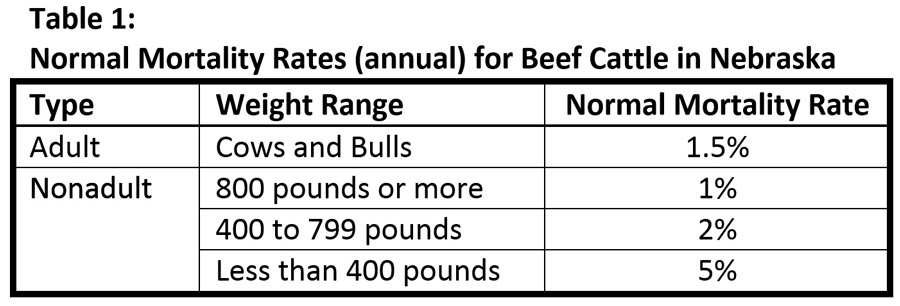Extreme Heat and the Livestock Indemnity Program
July 2016

With the extreme conditions we have been experiencing this summer, it is important producers diligently document and report their death losses for possible Livestock Indemnity Program (LIP) payments. It is a good risk management practice to keep good records anyway but it is at times like these that they can really pay dividends. In 2015, over $2.4 million in LIP payments were made to 129 Nebraska producers.
The Livestock Indemnity Program (LIP), administered by the USDA Farm Service Agency (FSA), provides compensation to eligible livestock producers who have suffered livestock death losses in excess of normal mortality due to adverse weather, including extreme heat and humidity.
Eligibility
FSA recently made a notable change to LIP regarding livestock owner eligibility. Beginning this year, the livestock owner does not have to have an interest in a farming operation in order to qualify for program benefits. In the past, this created issues for livestock owners who had an interest in cattle in a feedlot setting but didn’t necessarily own a farm. Now, a producer only has to have an interest in producing agricultural products, including commercial livestock, in order to be qualified to participate in LIP.
To be eligible for LIP payments, a producer must file a notice of loss on form CCC-852 with their local FSA office within 30 calendar days of when the death losses became apparent. The producer can then file an application for payment to request compensation for losses in excess of the normal mortality rate. This must be completed no later than 30 calendar days after the end of the calendar year in which the loss occurred (i.e., January 30, 2017 for the current year).
Multiple notices of losses and multiple applications for payment may be filed by producers that suffer multiple livestock losses during the same calendar year. Once a qualifying weather event has been identified, adult livestock dying within 60 days of that qualifying event can be considered eligible for loss benefits.
Payment
The LIP payment rates are based on 75 percent of the national market value of the livestock. For example, the 2015 payment rate for a 900 pound steer would have been $1,375.41 per head. With the current markets, these payments will be less for 2016 losses but still a potentially important cost recovery from the financial impacts of losing a larger than normal number of animals.
LIP payments are calculated based on eligible death losses in excess of normal annual mortality. Normal mortality rates are established by FSA on a state-by-state basis using recommendations from State livestock and Extension Service organizations. Table 1 contains the normal mortality rates established for beef cattle in Nebraska.

Documentation
Producers must document the number and kind of livestock that died. Preferably, this is supplemented with a video record or dated photo(s). It is important producers understand that the key piece in documenting death loss above normal mortality is good inventory records.
Producers need accurate counts of the number and type of livestock in their inventory before and after the eligible event. Beginning and ending year inventory numbers supplemented with production records, purchase records, sale records, veterinarian records, inventory related bank loan documentation, and other reliable documents can help verify livestock inventories at different points throughout the year.
The producer should continue to accurately document inventory counts and death losses throughout the year. Because once the annual death loss threshold (normal mortality) has been exceeded, subsequent death losses due to normal mortality or due to eligible events in the same calendar year may trigger additional losses eligible for LIP payments.
Factsheet
The Livestock Indemnity Program (LIP) Factsheet is available from the USDA Farm Service Agency website.
Jay Parsons
Farm and Ranch Management Specialist
Department of Agricultural Economics
University of Nebraska–Lincoln